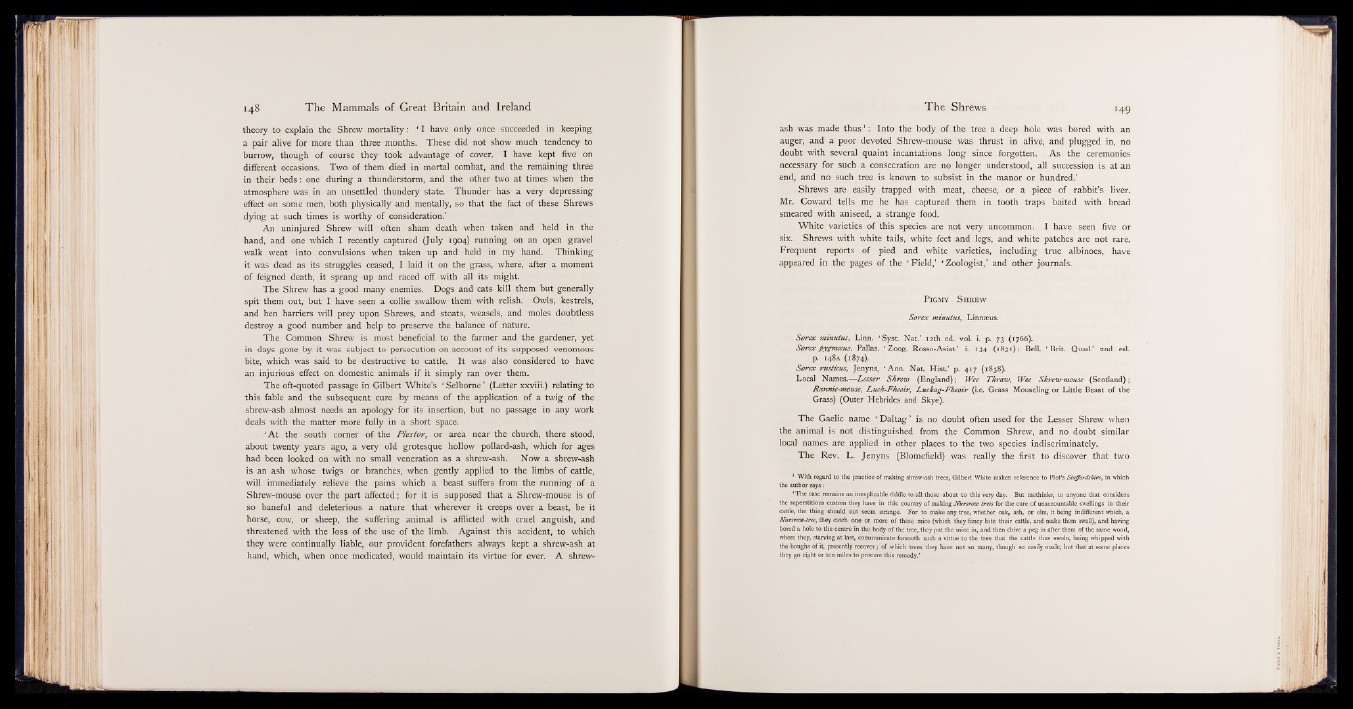
theory to explain the Shrew mortality: ‘ I have only once succeeded in keeping
a pair alive for more than three months. These did not show much tendency to
burrow, though of course they took advantage of cover. I have kept five on
different occasions. Two of them died in mortal combat, and the remaining three
in their beds: one during a thunderstorm, and the other two at times when the
atmosphere was in an unsettled thundery state. Thunder has a very depressing
effect on some men, both physically and mentally, so that the fact of these Shrews
dying at such times is worthy of consideration.’
An uninjured Shrew will often sham death when taken and held in the
hand, and one which I recently captured (July 1904) running on an open gravel
walk went into convulsions when taken up and held in my hand. Thinking
it was dead as its struggles ceased, I laid it on the grass, where, after a moment
of feigned death, it sprang up and raced off with all its might.
The Shrew has a good many enemies. Dogs and cats kill them but generally
spit them out, but I have seen a collie swallow them with relish. Owls, kestrels,
and hen harriers will prey upon Shrews, and stoats, weasels, and moles doubtless
destroy a good number and help to preserve the balance of nature.
The Common Shrew is most beneficial to the farmer and the gardener, yet
in days gone by it was subject to persecution on account of its supposed venomous
bite, which was said to be destructive to cattle. It was also considered to have
an injurious effect on domestic animals if it simply ran over them.
The oft-quoted passage in Gilbert White’s ‘ Selborne ’ (Letter xxviii.) relating to
this fable and the subsequent cure by means of the application of a twig of the
shrew-ash almost needs an apology for its insertion, but no passage in any work
deals with the matter more fully in a short space.
'A t the south corner of the Plestor, or area near the church, there stood,
about twenty years ago, a very old grotesque hollow pollard-ash, which for ages
had been looked on with no small veneration as a shrew-ash. Now a shrew-ash
is an ash whose twigs or branches, when gently applied to the limbs of cattle,
will immediately relieve the pains which a beast suffers from the running of a
Shrew-mouse over the part affected; for it is supposed that a Shrew-mouse is of
so baneful and deleterious a nature that wherever it creeps over a beast, be it
horse, cow, or sheep, the suffering animal is afflicted with cruel anguish, and
threatened with the loss of the use of the limb. Against this accident, to which
they were continually liable, our provident forefathers always kept a shrew-ash at
hand, which, when once medicated, would maintain its virtue for ever. A shrewash
was made thus1 : Into the body of the tree a deep hole was bored with an
auger, and a poor devoted Shrew-mouse was thrust in alive, and plugged in, no
doubt with several quaint incantations long since forgotten. As the ceremonies
necessary for such a consecration are no longer understood, all succession is at an
end, and no such tree is known to subsist in the manor or hundred.’
Shrews are easily trapped with meat, cheese, or a piece of rabbit’s liver.
Mr. Coward tells me he has captured them in tooth traps baited with bread
smeared with aniseed, a strange food.
White varieties of this species are not very uncommon. I have seen five or
six. Shrews with white tails, white feet and legs, and white patches are not rare.
Frequent reports of pied and white varieties, including true albinoes, have
appeared in the pages of the ‘ Field,’ ‘ Zoologist,’ and other journals.
P ig m y S h r e w
Sorex minutus, Linnaeus.
Sorex minutus, Linn. ‘ Syst. Nat.’ 12th ed. vol. i. p. 73 (1766).
Sorexpygmceus, Pallas, ‘ Zoog. Rosso-Asiat.’ i. 134 (1831); Bell, ‘ Brit. Quad.’ 2nd ed.
p. 148A (1874).
Sorex rusticus, Jenyns, ‘ Ann. Nat. Hist.’ p. 417 (1838).
Local Names.— Lesser Shrew (England); Wee Thraw, Wee Shrew-mouse (Scotland);
Rannie-mouse, Luck-Fkeoir, Luckag-Fheoir (i.e. Grass Mouseling or Little Beast o f the
Grass) (Outer Hebrides and Skye).
The Gaelic name ‘ Daltag ’ is no doubt often used for the Lesser Shrew when
the animal is not distinguished from the Common Shrew, and no doubt similar
local names are applied in other places to the two species indiscriminately.
The Rev. L. Jenyns (Blomefield) was really the first to discover that two
1 With regard to the practice of making shrew-ash trees, Gilbert White makes reference to Plot’s Staffordshire, in which
the author says:
‘The case remains an inexplicable riddle to all those about to this very day. But methinks, to anyone that considers
the superstitious custom they have in this country of making Nursrow trees for the cure of unaccountable swellings in their
cattle, the thing should hot seem strange. For to make any tree, whether oak, ash, or elm, it being indifferent which, a
Nursrow-tree, they catch one or more of these mice (which they fancy bite their cattle, and make them swell), and having
bored a hole to the centre in the body of the tree, they put the mice in, and then drive a peg in after them of the same wood,
where they, starving at last, communicate forsooth such a virtue to the tree that the cattle thus swoln, being whipped with
the boughs of it, presently recover; of which trees they have not so many, though so easily made, but that at some places
they go eight or ten miles to procure this remedy.’